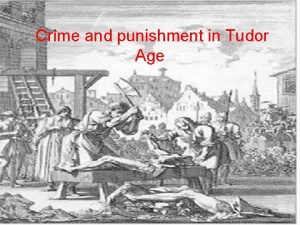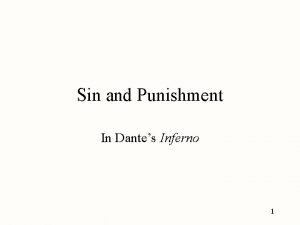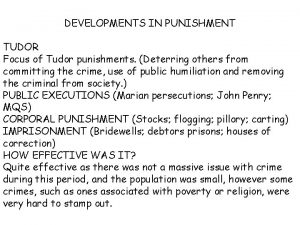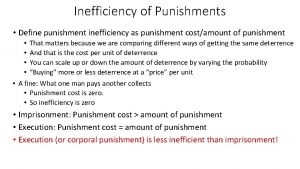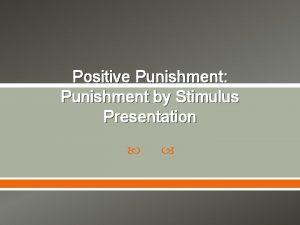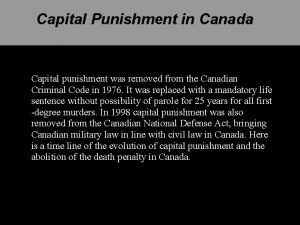DEVELOPMENTS IN PUNISHMENT TUDOR Focus of Tudor punishments

















- Slides: 17

DEVELOPMENTS IN PUNISHMENT TUDOR Focus of Tudor punishments. (Deterring others from committing the crime, use of public humiliation and removing the criminal from society. ) PUBLIC EXECUTIONS (Marian persecutions; John Penry; MQS) CORPORAL PUNISHMENT (Stocks; flogging; pillory; carting) IMPRISONMENT (Bridewells; debtors prisons; houses of correction) HOW EFFECTIVE WAS IT? Quite effective as there was not a massive issue with crime during this period, and the population was small, however some crimes, such as ones associated with poverty or religion, were very hard to stamp out.

DESCRIBE THE PUNISHMENT OF THE STOCKS (4 MARKS) (37) DESCRIBE THE USE OF PUBLIC EXECUTIONS IN TUDOR ENGLAND. (4 MARKS) (35 -36) DESCRIBE A BRIDEWELL (4 MARKS) (39) 1 MARK FOR SIMPLE STATEMENT. 2 -3 MARKS FOR BRIEF DESCRIPTION 4 MARKS FOR GOOD DESCRIPTION OF SEVERAL ASPECTS OF THEIR ROLE.

DEVELOPMENTS IN PUNISHMENT INDUSTRIAL Focus of Industrial punishment: INITIALLY to deter people with harsh punishments for crimes. GRADUALLY a small shift towards ‘reforming’ criminals. Constant focus on punishment by removal. Public hangings to entertain people banned. Bloody (criminal code) Transportation Criminal code reform (work of Peel; Samuel Romily) Prison reform (G. O. Paul; John Howard; Elizabeth Fry; separate and silent systems) HOW EFFECTIVE WAS IT? Developments initially were from a humanitarian focus, also, new police force helped reduce crime dramatically. HOWEVER, crime still quite high, and although there were huge steps towards reforming criminals, crimes of poverty continued.

DESCRIBE THE PUNISHMENT OF TRANSPORTATION (4 MARKS) DESCRIBE THE CRIMINAL CODE REFORM ACT. (4 MARKS) (USE PAGE 38/39 TO HELP) 1 MARK FOR SIMPLE STATEMENT. 2 -3 MARKS FOR BRIEF DESCRIPTION 4 MARKS FOR GOOD DESCRIPTION OF SEVERAL ASPECTS OF THEIR ROLE.

Criminal Code Reform Key players: Samuel Romilly, Robert Peel • By nineteenth century over 200 crimes are punishable by death. • Despite use of ‘Bloody Code’ crime still increasing. • Romilly campaigned for pickpocketing to no longer be a capital crime. • Eventualy Peel reduced number of capital crimes to five. • In the mid nineteenth century all executions became private NOT public. • Focus of punishment becomes more about rehabilitation/reform of prisoners.

Prisons in the Industrial Revolution Problems • Purpose to ‘remove’ criminals. • Poor sanitation, many died from disease in prison. • Jailers not paid, so made money from extorting prisoners. • Had to pay a ‘jailers fee’ to leave prison regardless of innocence or guilt. • No access to medical care. • No efforts to reform prisoners to stop them reoffending. Key developments • Campaign by John Howard led to Jails Act

Why was the Criminal Code Reform Act, 1823 a turning point in methods of punishment in Wales and England? (8 MARKS) 1 -3 MARKS – Basic answer which makes a couple of relevant points. 4 -6 MARKS – Gives some explanation as to how it marks a change in focus of punishments, reliance on policing and prisons, reform rather than retribution etc… 7 -8 MARKS – Developed explanation of multiple reasons which leads to a reasoned judgement which is focused on the question.

Howard was sheriff of Bedford, and a Christian who believed that prisons were cruel and unfair. In 1774, Howard persuaded government that prisons had to look after health of prisoners, also that discharge fees should be abolished. Wrote ‘the State of Prisons in England Wales’ in 1777, which highlighted problems such as conditions, although change was slow. His work inspired others such as Fry and Paul to get involved. G. O. Paul was a country magistrate who was influenced by Howard. Gloucestershire Act, 1785 gave him power to rebuild Gloucester Gaol. New prison separated prisoners into different types, and reformed them through work, education, and religion. Prisoners spent long periods of time in isolation to think about their mistakes and how they could change. This became the model for separate and silent prisons. v

SEPARATE SYSTEM • Pupils kept isolated from each other. • After weeks of non-contact, the prison chaplain would persuade the prisoner to lead a better, godlier life. • Pentonville prison opened in 1842 as a model “separate prison” and by 1850, there were 50 others using the system. • It was believed that this separation would give criminals time to reform through reflection. SILENT SYSTEM • Silent involved a prisoner doing a boring task in complete silence. They were forced to walk around “treadmills” like hamsters in a cage, unravel old rope or turn handles that scooped up and emptied cups of sand. • The idea was to allow a prisoner time to reflect on their crime, and not allow them any chance to corrupt each other. • From the 1850 s the crime rate was falling. The new, more lenient, prison system was well suited to a less crime-ridden society.

Elizabeth Fry: • Elizabeth Fry first visited London’s Newgate Prison in 1813 and spent the rest of her life trying to improve prison conditions. She encouraged prisoners to keep their cells clean and found them work knitting stockings for 2 p a week. • She also helped prisoners to read and write, began a school for prisoner’s children and held Bible readings. • A jail act of 1823, proposed by the Home Secretary, Robert Peel, began a long series of reforms that laid the foundations of our modern prison service. Elizabeth Fry’s work was important because she implemented specific reforms to help women in prisons. • She formed the Association for the Improvement of Female prisoners in Newgate prison. She set up a Ladies Prison Committee to help her with her reforming work, which was based on moral and religious reform. Discipline was improved through a set of rules and the women did needlework, so that they were improved characters and had some skill which could lead to employment on release from prison. Women prisoners were offered hope and improved lives due to the work of Elizabeth Fry. • • "Punishment is not for revenge, but to lessen crime and reform the criminal, "

Use Source B and C and your own knowledge to explain why prisons changed in the first half of the nineteenth century. (6 marks) 1 -2 MARKS – Picks information from source. 3 marks, describe using own knowledge. 4 marks – tries to identify how it why it has changed. 5 -6 MARKS – uses sources and own knowledge to explain why policing changed.

How important was the work of John Howard and G. O. Paul in improving prisons in the late eighteenth century? (8 MARKS) 1 -3 MARKS – Basic answer which makes a couple of relevant points. 4 -6 MARKS – Gives some explanation as to what they did and how it led to changes in prisons. 7 -8 MARKS – Developed explanation of multiple reasons which leads to a reasoned judgement which is focused on the question.

How important was the work of John Howard and G. O. Paul in improving prisons in the late eighteenth century? (8 MARKS) 1 -3 MARKS – Basic answer which makes a couple of relevant points. 4 -6 MARKS – Gives some explanation as to what they did and how it led to changes in prisons. 7 -8 MARKS – Developed explanation of multiple reasons which leads to a reasoned judgement which is focused on the question.

DEVELOPMENTS IN PUNISHMENTS MODERN Massive focus on reform and a growing awareness of the moral implications of punishments. Still some focus on removal but also reform and restitution. Abolition of corporal and capital punishment Changes to prisons (open prisons; Borstals; Young Offender Institutes; Conditions in prisons) Alternatives to imprisonment (suspended sentences; tagging; ASBOs; probation and parole; community service. ) HOW EFFECTIVE WAS IT? Murder rate did not drop massively after removal of capital punishment nor did it rise massively. Some success with reforming criminals both through community service and prison reform/education programmes. Overcrowding in prisons is also an issue with modern punishments.

WHY WAS CAPITAL PUNISHMENT ABOLISHED? • Focus of punishment was now on reforming criminals. • Several high profile cases including that of Derek Bentley highlighted the flaws in the use of capital punishment. • After all the death and suffering of WWII many people had seen enough death. • Prisons were improving. HOW WAS CAPITAL PUNISHMENT ABOLISHED? • Under the terms of the Murder (Abolition of Death Penalty) Act 1965 hanging was suspended for an experimental period of five years. • After there was seen to be no major change in the murder rate the Murder Act was adopted permanently in 1969. The abolition of the death sentence everywhere under British rule marks the end of a long road of reform since the early 19 th century, when Britain’s “Bloody Code” imposed the death penalty for 200 offences. WHAT WERE THE CONSEQUENCES OF THIS CHANGE? • Focus of punishment was now on reforming criminals. • Led to further focus on use of prisons. • Led to the creation of new punishments such as community service, suspended sentences and tagging to take the strain off overcrowded prisons.

How can the abolition of capital punishment be seen as a turning point in punishment? (8 MARKS) 1 -3 MARKS – Basic answer which makes a couple of relevant points. 4 -6 MARKS – Identifies how it was abolished, and what developments it led to. 7 -8 MARKS – Developed explanation of multiple reasons which leads to a reasoned judgement which is focused on the question.

What important developments were made in the prison system in the twentieth century? (8 MARKS) 1 -3 MARKS – Basic answer which makes a couple of relevant points. 4 -6 MARKS – Identifies changes and explains why they were important. (Borstals, YOI, Open prisons, education of prisoners) 7 -8 MARKS – Developed explanation of multiple reasons which leads to a reasoned judgement which is focused on the question.
 Tudor whipping
Tudor whipping Focus on form vs focus on forms
Focus on form vs focus on forms Cost focus and differentiation focus
Cost focus and differentiation focus Timex cost leadership strategy
Timex cost leadership strategy Actor focus vs object focus
Actor focus vs object focus Inferno punishments
Inferno punishments Nnn punishments
Nnn punishments Good nnn punishments
Good nnn punishments Victorian punishments in school
Victorian punishments in school Discipline without punishment
Discipline without punishment Education in the 50s
Education in the 50s Puritan stocks punishment
Puritan stocks punishment Victorian school punishments
Victorian school punishments The target person complies in order to obtain
The target person complies in order to obtain Nnn punishments
Nnn punishments Christian domestic discipline examples
Christian domestic discipline examples Dante's inferno the nine circles of hell
Dante's inferno the nine circles of hell Nnn punishment
Nnn punishment
